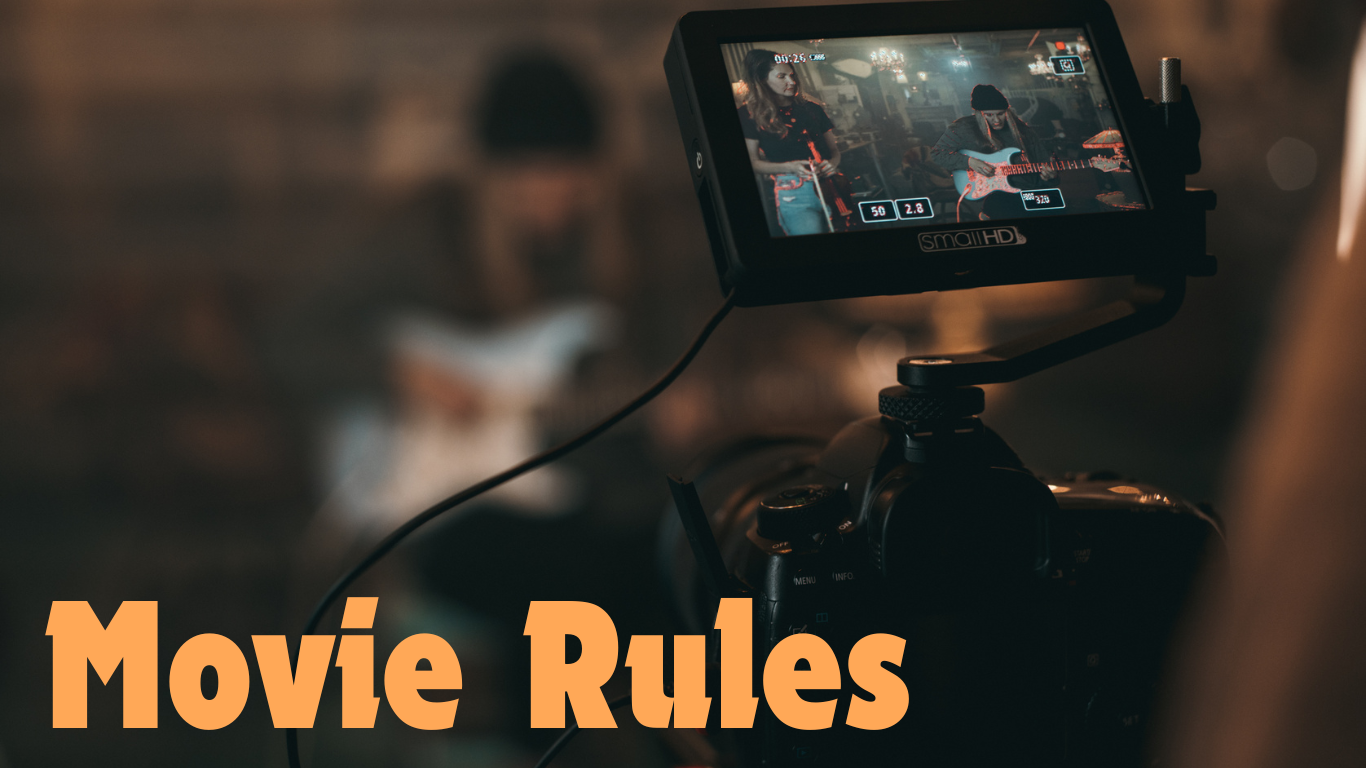Introduction
Whether you’re a filmmaker, screenwriter, or an avid movie watcher, understanding the rules that govern the creation of films can enhance your appreciation of the art form. These “movie rules” aren’t just guidelines for directors and writers; they influence everything from the structure of a story to the visual aesthetics of a film. This guide will explore the various types of movie rules, how they shape our cinematic experiences, and the impact they have on the creative process. We’ll dive into examples from popular films, discuss the importance of adhering to or breaking these rules, and provide insights into how you can apply these concepts in your own projects.
The Purpose of Movie Rules
Establishing Structure and Consistency in Film
Movie rules serve as the backbone for creating a structured and coherent film. They ensure that a movie follows a logical sequence, which helps in delivering a story that is easy for audiences to follow. For instance, most films adhere to a three-act structure – a beginning, middle, and end – which provides a clear narrative arc that guides the viewer through the story.
Enhancing Viewer Engagement
Consistent application of movie rules can significantly enhance viewer engagement. When a movie follows established conventions, it meets audience expectations, allowing them to become immersed in the story. Whether it’s the predictable beats of a romantic comedy or the tension-building techniques in a horror film, these rules are designed to evoke specific emotions and responses from the audience.
Ensuring Genre Integrity
Different genres come with their own set of rules. For instance, horror movies typically involve isolated settings, a mysterious antagonist, and a group of unsuspecting victims. These elements are not just clichés; they are the building blocks that define the genre. By adhering to these rules, filmmakers ensure that their movies stay true to genre conventions, satisfying the audience’s expectations.
Setting Boundaries for Creativity
While rules might seem restrictive, they actually provide a framework within which creativity can flourish. Knowing the boundaries allows filmmakers to innovate and surprise their audience within a familiar context. For example, while most superhero movies follow a certain formula, films like “Deadpool” and “Logan” have successfully bent the rules to offer something fresh and exciting.
Common Types of Movie Rules
Genre-Specific Rules
Horror Movie Rules
Horror films often follow a set of rules designed to build suspense and terror. These include setting the story in a location that is isolated or claustrophobic, using jump scares at strategic points, and creating a villain who embodies fear and unpredictability. Classic horror films like “Halloween” and “The Exorcist” adhere to these rules, while modern films like “Get Out” have innovated within the genre to deliver fresh scares.
Romantic Comedy Rules
Romantic comedies, or rom-coms, are known for their lighthearted, often predictable plots where two seemingly mismatched characters fall in love. The genre typically follows a formula: a meet-cute moment, followed by a series of humorous misunderstandings or challenges, leading to a grand romantic gesture that resolves the conflict. Movies like “When Harry Met Sally” and “Notting Hill” are prime examples of rom-coms that perfectly follow these genre rules.
Action Movie Rules
Action movies are all about adrenaline, featuring fast-paced sequences, high stakes, and a hero who must overcome incredible odds. The rules of this genre often include elaborate fight scenes, car chases, and a villain who poses a significant threat to the protagonist and the world. Films like “Die Hard” and “Mad Max: Fury Road” are classic examples that adhere to these rules while delivering exhilarating experiences.
Narrative and Plot Rules
The Three-Act Structure
The three-act structure is one of the most fundamental narrative rules in filmmaking. It divides the story into three parts: the setup, the confrontation, and the resolution. This structure helps to create a well-paced and engaging narrative that keeps the audience invested from beginning to end. Nearly all Hollywood films, from “The Godfather” to “The Avengers,” utilize this structure to great effect.
Character Arcs and Development
Another crucial narrative rule is the development of character arcs. Characters in a movie, especially the protagonist, should undergo significant growth or change by the end of the story. This transformation is often a key element that drives the plot forward. Films like “Breaking Bad” and “The Dark Knight” showcase how effective character development can elevate a movie’s narrative.
Visual and Aesthetic Rules
Color Theory in Film
Color theory plays a significant role in the visual storytelling of a movie. Different colors evoke different emotions and can be used to highlight themes or character traits. For example, the use of red might symbolize danger or passion, while blue might represent calm or sadness. Directors like Wes Anderson and Stanley Kubrick are known for their meticulous use of color to enhance the storytelling in their films.
Cinematography Techniques
Cinematography is another area where specific rules apply. Techniques such as the rule of thirds, leading lines, and the use of lighting all contribute to the visual composition of a scene. These rules help create visually striking images that support the narrative. The work of cinematographers like Roger Deakins in “Blade Runner 2049” and Emmanuel Lubezki in “The Revenant” demonstrates the power of following these visual rules.
Ethical and Legal Rules
Copyright and Intellectual Property
Filmmakers must adhere to legal rules regarding copyright and intellectual property. This ensures that the content they create does not infringe on the rights of others. Copyright law protects the original works of creators, meaning filmmakers must obtain permission to use existing content or create something entirely new. Failure to follow these rules can lead to legal disputes and financial penalties.
Censorship and Rating Guidelines
Censorship and rating guidelines are put in place to protect audiences from inappropriate content. Different countries have different systems for rating movies, and filmmakers must consider these guidelines when creating their films. For example, a movie that includes graphic violence or explicit content might receive a higher rating, limiting its audience. Understanding and adhering to these rules is essential for filmmakers who want their work to reach the widest possible audience.
Iconic Movie Rules in Popular Culture
“Scream” and the Rules of Surviving a Horror Movie
The “Scream” franchise, directed by Wes Craven, famously highlighted the rules of horror movies through its self-aware characters. These rules include avoiding certain behaviors like splitting up or saying, “I’ll be right back,” which are often followed by the character’s demise. By explicitly stating these rules, “Scream” played with genre conventions while still delivering a classic slasher film experience.
“The Rules of Fight Club” – Cultural Impact
David Fincher’s “Fight Club” introduced its own set of rules, the most famous being, “The first rule of Fight Club is: You do not talk about Fight Club.” These rules not only serve the plot but have also become iconic in popular culture, symbolizing the underground, rebellious nature of the story.
The “Disney Formula” – Rules of a Successful Family Film
Disney has developed a formulaic approach to creating successful family films, often referred to as the “Disney formula.” This includes elements like a young protagonist, talking animals or objects, and a moral lesson. Movies like “The Lion King” and “Frozen” are prime examples of this formula in action, creating timeless stories that appeal to audiences of all ages.
James Bond – The Unwritten Rules of a Spy Thriller
The James Bond franchise is built on a set of unwritten rules that define the spy thriller genre. These include the suave, unflappable hero, exotic locations, high-tech gadgets, and a charismatic villain. While each Bond film offers a new adventure, they all adhere to these core rules, ensuring that the franchise remains consistent and beloved by fans.
How Movie Rules Influence Audience Expectations
Shaping Audience Anticipation
Movie rules play a significant role in shaping audience anticipation. When viewers know the rules of a genre, they come to a movie with certain expectations. For instance, in a mystery film, audiences expect a series of clues that lead to a surprising reveal. These expectations are crucial for maintaining viewer engagement and satisfaction.
Creating Predictability and Surprises
While predictability in movies can be comforting, it can also lead to boredom if overused. This is where the clever application of movie rules comes into play. Filmmakers can use established rules to set up expectations and then subvert them to create surprising and memorable moments. Movies like “The Sixth Sense” and “Psycho” are examples where the rules are followed just enough to lull the audience into a false sense of security before delivering a shocking twist.
The Role of Tropes and Clichés
Tropes and clichés are common in movies and are often the result of movie rules being followed too rigidly. While they can sometimes be effective, overuse of tropes can make a movie feel predictable and uninspired. However, when used creatively or subverted, these elements can add depth and intrigue to a film. For example, “Cabin in the Woods” plays with horror movie clichés to deliver a fresh and engaging narrative.
Breaking the Rules: When It Works and When It Doesn’t
Breaking movie rules can lead to innovative and groundbreaking films, but it’s a risky move. When done correctly, as in “Pulp Fiction,” it can result in a masterpiece that challenges the status quo. However, if the rules are broken without a clear purpose or understanding, it can lead to a disjointed and confusing film. The key to successfully breaking the rules lies in knowing them well enough to subvert them meaningfully.
The Role of Movie Rules in Screenwriting
Why Screenwriters Follow Movie Rules
Screenwriters follow movie rules to ensure that their scripts are coherent, engaging, and marketable. Adhering to established structures and conventions helps writers create stories that resonate with audiences and fit within the expectations of the industry. By following these rules, screenwriters increase the likelihood of their scripts being produced and appreciated.
Balancing Rules with Creativity
While it’s important for screenwriters to understand and follow movie rules, creativity is still essential. The best scripts often balance adherence to rules with innovative storytelling. For instance, Quentin Tarantino’s scripts often follow conventional structures but are filled with unique dialogue and unexpected plot twists that keep audiences engaged.
Examples of Screenwriting Successes and Failures
Successful screenplays like “The Social Network” and “Inception” follow movie rules while introducing new ideas and perspectives, resulting in critically acclaimed films. On the other hand, movies that fail to balance rules and creativity, such as “Batman & Robin,” often suffer from poor reception due to their reliance on clichés and lack of originality.
Screenwriting Software and Tools for Ensuring Rule Adherence
There are various screenwriting software tools available that help writers adhere to movie rules. Programs like Final Draft and Celtx offer templates and guidelines for structuring scripts according to industry standards. These tools can be invaluable for ensuring that a screenplay is properly formatted and follows the necessary rules for successful storytelling.
Movie Rules and Filmmaking Techniques
Directing with Movie Rules in Mind
Directors must keep movie rules in mind throughout the filmmaking process. This includes decisions about pacing, shot composition, and actor direction. By adhering to these rules, directors can create films that are visually and narratively cohesive. For example, Alfred Hitchcock’s meticulous adherence to suspense-building techniques has made his films timeless.
Editing to Maintain Consistency
Editing is where movie rules are often enforced or reinforced. Editors work to ensure that the pacing and continuity of the film adhere to established rules, creating a seamless viewing experience. Techniques like the 180-degree rule in editing help maintain spatial consistency, preventing confusion for the audience.
Sound Design and Music Rules
Sound design and music play crucial roles in enhancing the narrative and emotional impact of a film. There are specific rules for using sound and music, such as the “Leitmotif” technique in film scores, where a particular theme is associated with a character or idea. John Williams’ use of leitmotifs in “Star Wars” is a prime example of how following sound design rules can create an iconic film experience.
Lighting and Set Design Considerations
Lighting and set design are governed by rules that help create the desired mood and atmosphere for a film. For example, high-key lighting is often used in comedies to create a bright and cheerful environment, while low-key lighting is common in thrillers and horror films to evoke tension and fear. Set design must also adhere to rules that support the story, such as using colors and textures that reflect the film’s themes.
Ethical Considerations and Controversies Surrounding Movie Rules
Representation and Stereotyping
One of the significant ethical considerations in movie rules is the representation of different groups. Stereotyping can occur when filmmakers adhere too rigidly to outdated or harmful rules about how certain characters or cultures should be portrayed. There is growing awareness and pushback against such practices, with more filmmakers striving to break these rules to provide more accurate and diverse representations.
The Impact of Censorship on Creative Freedom
Censorship is a contentious issue in filmmaking. While rating systems are designed to protect viewers, they can also limit creative freedom. Filmmakers often face the dilemma of either adhering to censorship guidelines to reach a broader audience or pushing boundaries to stay true to their artistic vision. The controversy surrounding films like “The Last Temptation of Christ” and “A Clockwork Orange” highlights the ongoing debate about censorship in cinema.
The Debate Over Violence and Content in Movies
The portrayal of violence in movies is another area where ethical considerations come into play. There is ongoing debate about whether certain movie rules should restrict the level of violence depicted on screen, particularly in films accessible to younger audiences. Filmmakers must navigate these rules carefully, balancing the need for dramatic tension with ethical concerns about the impact of violent content.
Ethical Dilemmas in Portraying Real-Life Events
Movies based on real-life events come with their own set of ethical rules. Filmmakers must decide how accurately to portray these events while considering the potential impact on those involved. Movies like “Schindler’s List” and “The Social Network” have sparked discussions about the ethical responsibilities of filmmakers when depicting historical or biographical stories.
Case Studies of Movies That Successfully Followed or Broke the Rules
“Get Out” – A Rule-Breaking Success in Horror
“Get Out,” directed by Jordan Peele, is an example of a horror film that successfully broke traditional genre rules. By incorporating social commentary into the horror narrative, Peele created a film that was both terrifying and thought-provoking. This innovative approach not only entertained audiences but also sparked discussions about race and society.
“La La Land” – Blending and Bending Genre Rules
“La La Land” is a film that blends the rules of the musical genre with the conventions of romantic drama. While it follows many of the traditional rules of a musical, it also bends them by incorporating elements of realism and bittersweet endings, making it a unique entry in both genres.
“Mad Max: Fury Road” – Adhering to and Redefining Action Movie Rules
“Mad Max: Fury Road” is a masterclass in adhering to and redefining the rules of action filmmaking. The movie sticks to the core elements of the genre, such as intense chase scenes and a clear protagonist, but it also innovates by focusing on minimal dialogue and using visual storytelling to drive the narrative.
“The Blair Witch Project” – Innovating Within the Found Footage Genre
“The Blair Witch Project” is a film that followed the rules of the found footage genre while also innovating within it. By using a low-budget, realistic approach, the filmmakers created a sense of authenticity that heightened the horror for audiences. The film’s success paved the way for a new wave of found footage horror films.
The Future of Movie Rules
Evolving Genre Expectations
As audiences evolve, so do their expectations, leading to changes in movie rules. Genres that were once rigid are now more flexible, with filmmakers experimenting with new approaches to storytelling. This evolution is likely to continue, with future films pushing the boundaries of what is expected within established genres.
The Impact of Technology on Movie Rules
Advances in technology, such as CGI, virtual reality, and AI, are changing the rules of filmmaking. These tools allow filmmakers to create more immersive and visually stunning experiences, which could lead to new rules and conventions in the industry. For example, the rise of streaming platforms is already influencing how movies are made, distributed, and consumed.
How Streaming Services Are Changing the Game
Streaming services like Netflix and Amazon Prime are disrupting traditional movie rules. The freedom to create content without the constraints of box office demands or censorship has led to more diverse and experimental films. This shift is likely to continue, with streaming services setting new trends and influencing the future of movie rules.
Predictions for the Next Decade in Filmmaking Rules
The next decade in filmmaking is likely to see continued innovation in both technology and storytelling. Filmmakers will explore new ways to engage audiences, whether through interactive films, virtual reality experiences, or blending different genres. As these trends develop, movie rules will adapt, leading to an exciting future for the industry.
How to Apply Movie Rules in Your Own Projects
Understanding the Rules of Your Genre
Before you can innovate, you must understand the rules of the genre you’re working in. Study successful films in your chosen genre to identify common elements and conventions. This knowledge will provide a solid foundation for your creative process.
Using Movie Rules as a Guideline, Not a Restriction
Movie rules should guide your creativity, not restrict it. Use them as a framework within which you can experiment and innovate. Don’t be afraid to bend or break the rules if it serves the story you want to tell.
Innovating Within the Framework of Established Rules
Some of the most successful films are those that respect movie rules while introducing something new. Consider how you can add a fresh perspective or twist to familiar conventions. Innovation doesn’t mean ignoring the rules; it means using them in new and exciting ways.
Getting Feedback and Revising Your Approach
Feedback is essential in the filmmaking process. Share your ideas and drafts with peers, mentors, or focus groups to gain insights into how well you’re adhering to or innovating within the rules. Use this feedback to refine your approach and improve your project.
FAQs about Movie Rules
What Are the Most Common Movie Rules?
The most common movie rules include the three-act structure, character development, genre-specific conventions, and visual storytelling techniques.
Why Do Movies Need Rules?
Movies need rules to create structure, ensure consistency, and meet audience expectations. These rules help guide the storytelling process and make films more engaging.
Can Breaking Movie Rules Lead to Success?
Yes, breaking movie rules can lead to success if done thoughtfully. Films that successfully break the rules often introduce new ideas and perspectives, making them stand out.
How Do Movie Rules Differ Across Genres?
Movie rules differ across genres based on audience expectations and the conventions of that genre. For example, horror films focus on building suspense, while comedies emphasize humor and timing.
What Are the Ethical Considerations of Movie Rules?
Ethical considerations include accurate representation, avoiding stereotypes, and balancing creative freedom with the potential impact on audiences. Filmmakers must navigate these issues carefully.
Conclusion
Movie rules are an essential part of the filmmaking process, providing the structure and guidelines needed to create engaging and coherent films. Whether you’re a filmmaker, screenwriter, or movie enthusiast, understanding these rules can enhance your appreciation of cinema and help you create better stories. While following the rules is important, knowing when and how to break them can lead to innovation and success. As the film industry continues to evolve, so too will the rules that govern it, offering endless possibilities for creativity and storytelling.




